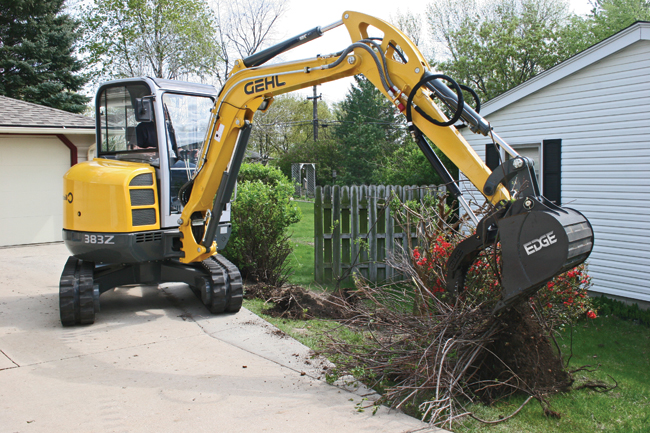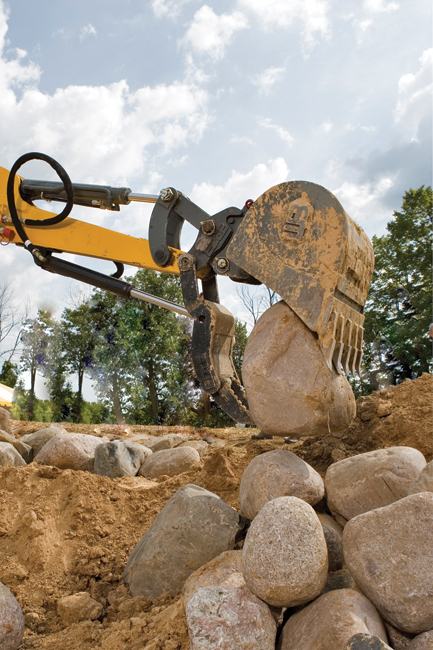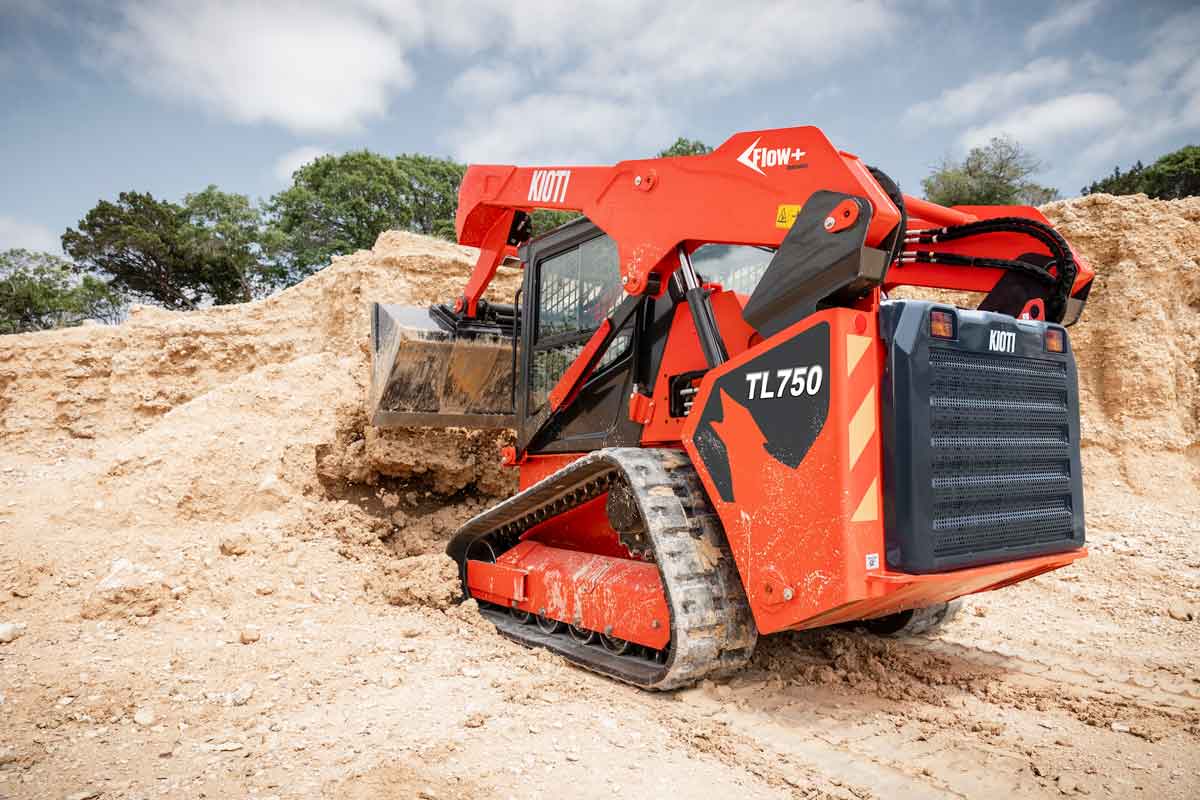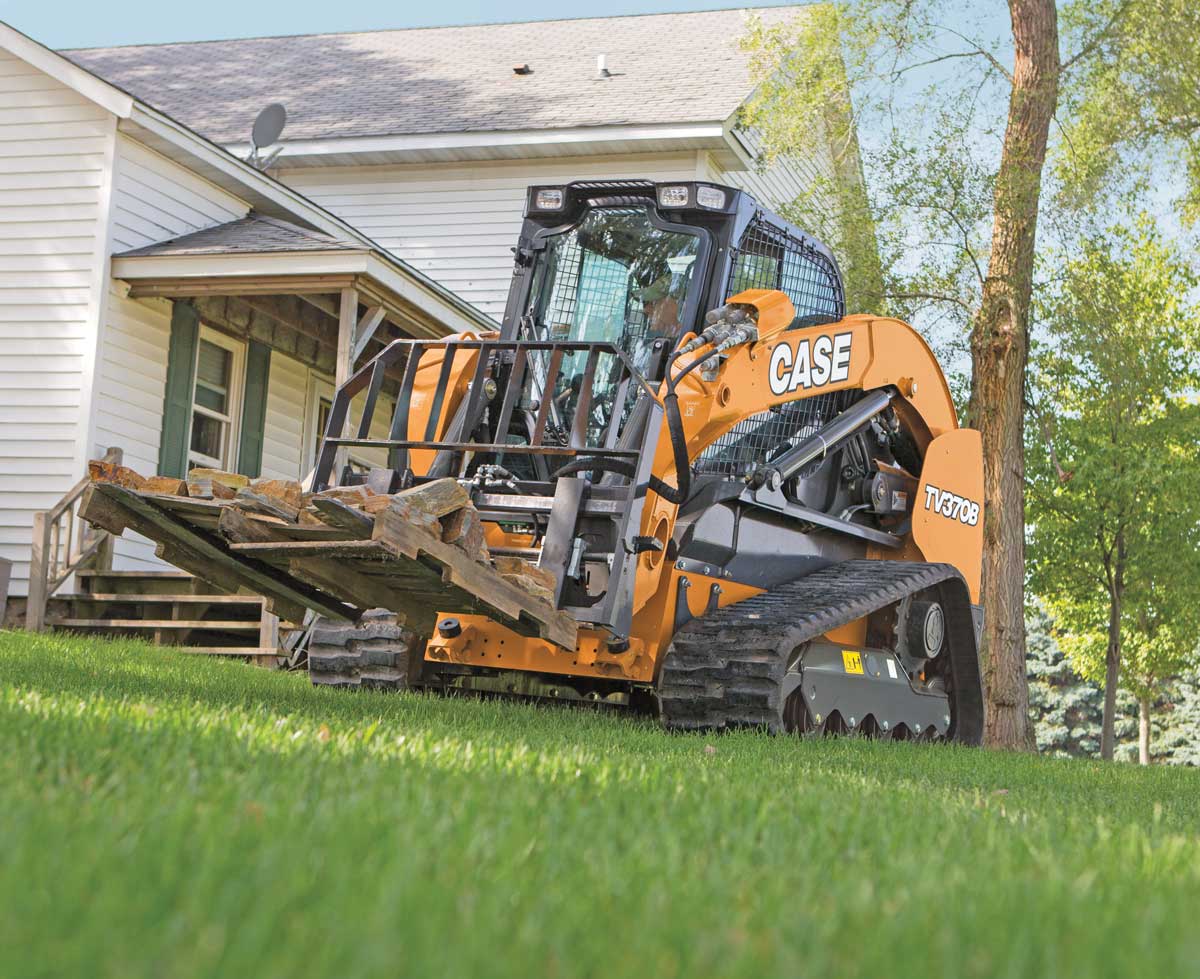Catch and Release
Having a machine with a bulldog grip is an important advantage for construction-focused contractors, especially when moving products or spoils from Point A to Point B. Pair a thumb attachment to a compact excavator bucket and you have steel jaws that can capture, catch, clutch and collar objects as diverse as big landscape rocks and as awkward as rebar debris.
“You see these home improvement deals where they bring rocks in to make some architectural gardens,” says Steve Harden, technical service manager with Paladin Construction Group (a global attachment manufacturer and specialist). “If you have a mini excavator with a thumb attachment, you can carry and set big rocks in a small confined area.”
Thumb attachments are great for picking and placing brush and trees, clearing land and aiding in demolition. They work well with moving concrete during road building and repair, logs in land-clearing applications and debris from demo work. Ryan Connelly, who works with heavyline product marketing at JCB (a manufacturer of many excavators under 6 metric tons), says a compact excavator with a thumb attachment easily turns mundane, back-breaking work into quick jobs.

“Thumbs are good for any material-handling type job. They make it possible for the machine to do the work rather than having to use multiple workers to move the material manually,” he says.
Ron Peters, product manager at CEAttachments (a global supplier of attachments for skid steer and track loaders, compact excavators and compact utility tractors), says thumb attachments help with both small and large jobs, from helping move big pieces on a project to cleaning up the leftovers.
“They are generally used to pick up different materials at construction sites. With landscapers, you can move rocks with them, pick up branches or different things that are laying on the jobsite that you want to move,” he says. “You can use them for sorting material, like if you’re trying to move something to a different pile and sort things like rebar or concrete.”
There are two main types of thumb attachments — mechanical and hydraulic. Hydraulic thumbs can open and close with the help of a hydraulic cylinder. Operators are able to reposition the thumb from inside the machine using controls. A mechanical thumb stays rigid or fixed. Rigid thumbs must be adjusted manually and locked into place. Rigid thumbs use the bucket to pinch materials in order to move them from spot to spot.
“Rigid is obviously the simpler and cheaper option as it requires no hydraulics,” Connelly says. “The hydraulic option will allow for more precise positioning, efficient operation and a greater range of movement between the thumb and bucket as compared to the mechanical stiff arm thumb design.”
Peters says the large majority of thumb attachments moving out of CEAttachments is hydraulic.
“Hydraulic thumbs are more versatile and easier to use because they allow you to move the thumb and curl the bucket by simply activating a switch in the cab. Rigid thumbs must be adjusted manually and you would only be able to curl the bucket,” he says. “If there’s a demolition project, they would definitely want a thumb on it, so they can use them to pick up different material.”
Thumbs are usually categorized by the weight class of the excavator. Bucket size is also considered. Most thumb attachment manufacturers and installers help to design around different makes and models of excavators. Pricing ranges from $2,000 to $5,000, with rigid thumbs being less expensive. A thumb isn’t a must-have for a compact excavator. It really depends on what projects will be taken on.
“Some people will never use a thumb and some will use a thumb 60 percent of the machine’s life,” Harden says. “It depends on the application. People who do land clearing, demolition work, concrete removal and recycling can benefit the most from thumbs, but it’s really up to the end-user.”
No minimum requirement flow is necessary as all compact excavators offer more than enough hydraulic power to power a thumb, but some machines may require a pressure relief valve installed in the compact excavator if it does not have one. A port or pressure relief valve is a protective device like a fuse (to put it in electrical terms). Envision grabbing a telephone pole horizontally with your mini excavator and thumb. If you tried to drive through two vertical poles — something has got to give — so the port relief valve allows the hydraulic pressure in the thumb cylinder to release its grip in overload situations.
Oftentimes, thumbs paired with buckets don’t offer the appropriate grasp for bigger and more accurate job descriptions. That’s where a grapple or clamshell-styled bucket can come into play. The fixed grapple is the most popular style of grapple for compact excavators (two jaws — one with three tines and one with two tines — making a mechanical hand). The grapple reacts to the bucket curl, rolling out to open and curling up to grip timber, pipes, boulders, rocks, demolition and debris. This attachment may require you to weld a mount to the dipper arm of your excavator, allowing the operator to use the bucket curl cylinder to close the grapple. Sizes are often determined by the size class of the compact excavator (operating weight), but manufacturers often build fixed grapples with sizes from 24 to 36 in.
Fixed grapples can cost from $2,500 to $5,000 and are easily installed using the compact excavator’s universal quick-attach system. If you’re looking for something a little bigger, more maneuverable and more precise, then rotating grapples and rotating buckets are the ultimate, accurate iron fist on the jobsite. With multi-function capabilities and 360-degree rotation, a rotating grapple attachment allows a compact excavator to do precision landscape work or heavy-duty scrap and recycling applications, twisting the grapple on a rotator for quick and skillful pickups and deliveries. Regardless of the gripping solution, you must know what you want to do with your compact excavator before exploring all your options.

“That decision depends on the application for which the excavator will be used,” says Connelly. “Thumbs, for instance, can be retrofitted but will be a little more expensive and labor-intensive to install. However, there’s no need to pay upfront if your current application doesn’t require the use of a thumb or another gripping attachment. If the application does require a thumb, then it will be a better option to have it included so that the operation will be more productive.”
Kelly Pickerel is assistant editor of Compact Equipment, based in Peninsula, Ohio.




